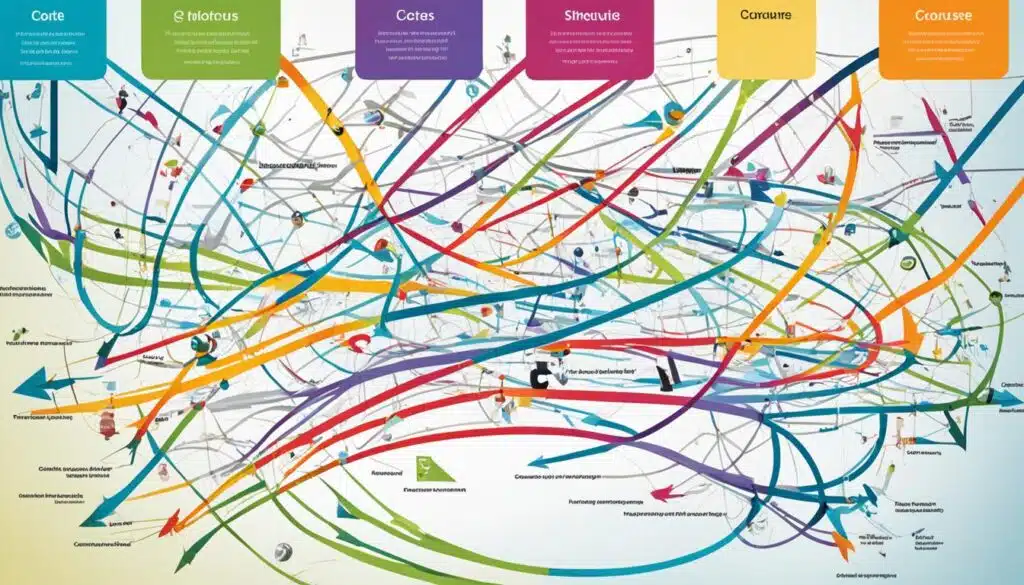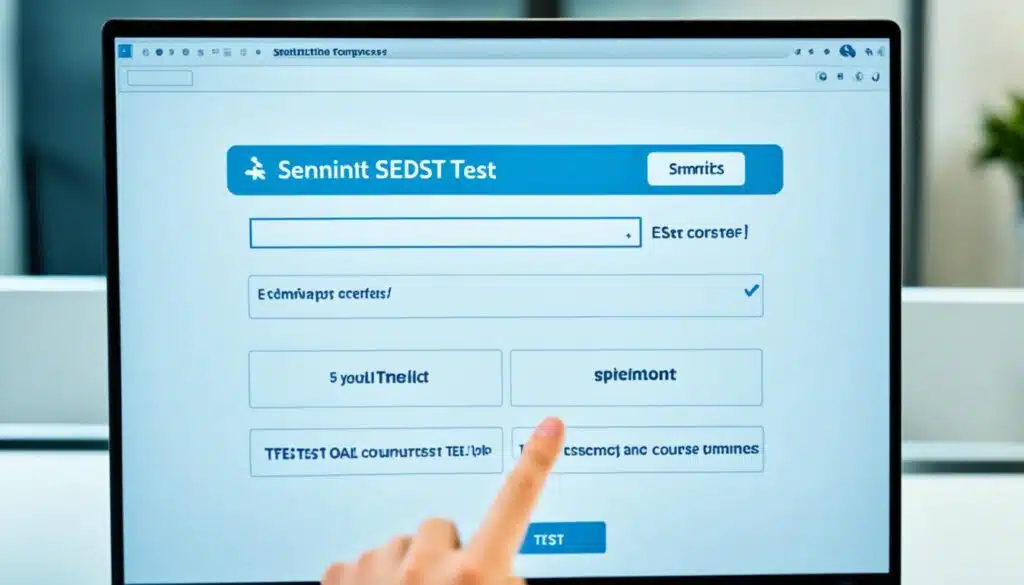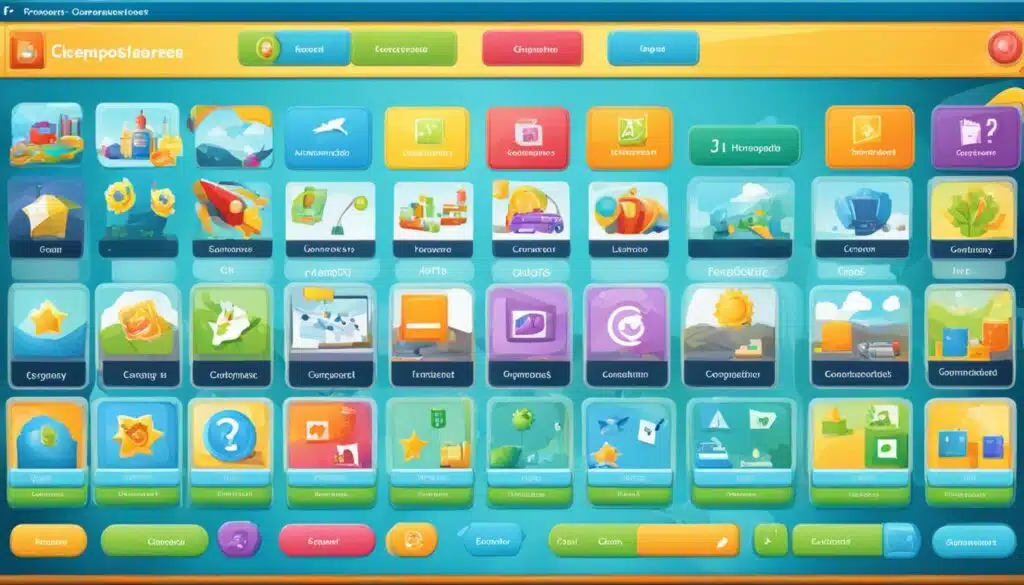The demand for online courses has never been higher. Whether you’re an educator, entrepreneur, or industry expert, creating an online course can be a rewarding way to share your knowledge and reach a global audience. But how do you create a course that truly engages learners and helps them achieve their learning goals?
In this article, we will guide you through the process of creating engaging online courses. From content preparation to course structure, we will explore the key elements that will captivate learners and make your course stand out.
Key Takeaways: Create Engaging Courses Online –
- Create a course that captivates learners and helps them achieve their learning goals.
- Define specific learning goals and outcomes to guide your course content.
- Choose the right format for your content to enhance the learning experience.
- Create a cohesive structure that keeps learners engaged from start to finish.
- Use multimedia elements and maintain a consistent visual style to enhance engagement.
Prepare Your Course Content
When creating an online course, the starting point is to establish clear learning goals and outcomes. These goals will serve as the foundation for developing your course content, ensuring that it aligns with the desired outcomes. By setting specific and measurable objectives, you can create targeted and effective courses that cater to your learners’ needs.
Defining the course topic is crucial in determining the focus of your content. It helps you narrow down the subject matter and deliver in-depth knowledge on a specific subject. This ensures that your learners receive a comprehensive understanding of the chosen topic.
To provide a structured learning experience, it’s essential to create a course outline that outlines the main sections and subtopics you will cover. This not only helps you organize the content but also allows learners to navigate through the course more efficiently.
Additionally, leveraging a variety of teaching methods, such as lectures, readings, case studies, and interactive activities, can enhance learner engagement and facilitate knowledge retention.
| Benefits of Preparing Your Course Content |
|---|
| Ensures alignment with learning goals and outcomes |
| Provides clarity and focus on the chosen course topic |
| Facilitates efficient navigation through the course outline |
| Enhances learner engagement through diverse teaching methods |
By carefully preparing your course content, you can deliver a well-structured and engaging learning experience for your online learners, enabling them to achieve their learning objectives effectively.
Choose the Right Format

When creating an online course, one of the key factors that can significantly impact learner engagement is choosing the right format for your content. The course format refers to how the course material is structured and presented to the learners. By selecting the appropriate format, you can enhance the learning experience and keep your learners engaged throughout the course.
To determine the best format for your course, consider the following factors:
- Target Audience: Understand the characteristics, preferences, and learning styles of your target audience. For instance, if your audience consists of busy professionals, a self-paced format with bite-sized modules might work best.
- Course Topic: Consider the nature of your course topic and the most effective way of delivering the content. Some topics may lend themselves well to video-based lectures, while others may require interactive simulations or real-world case studies.
- Learner Accessibility: Determine how your learners will access the course. Is it primarily desktop-based or mobile-friendly? This information will help you design the content format that optimizes the learning experience based on the devices your learners are most likely to use.
By carefully considering these factors, you can select the most suitable course format that aligns with your learners’ needs and preferences. This will ensure that your course content is delivered in the most engaging and effective way possible.
Comparison of Common eLearning Formats
| Course Format | Key Features | Pros | Cons |
|---|---|---|---|
| Video Lectures | Deliver content through pre-recorded video lectures. |
|
|
| Interactive Simulations | Provide learners with hands-on experiences through interactive simulations. |
|
|
| Discussion Forums | Facilitate online discussions and peer-to-peer learning. |
|
|
Create a Cohesive Structure

A well-structured course is the cornerstone of learner engagement. By carefully planning the course structure, you can guide your learners through a seamless learning experience. Here are some key steps to create a cohesive structure:
- Storyboard your course: Use storyboarding techniques to outline the flow of your course. This visual planning method helps you organize the content into manageable modules and learning paths.
- Divide into modules: Breaking your course into convenient modules helps keep the content focused and digestible. Each module should cover a specific topic or learning objective.
- Create learning paths: Consider the logical progression of your course and determine the ideal learning paths for your learners. This ensures a smooth and purposeful journey through the material.
By utilizing these strategies, you can design a concise and organized course that keeps learners engaged from start to finish.
A well-structured course ensures learners can follow a clear path towards their learning goals. It provides a sense of direction and progression, which enhances the overall learning experience. Additionally, learners benefit from a well-paced course that respects their time commitments.
Develop Engaging Course Content

When it comes to creating an online course, developing engaging course content is key to capturing and retaining your learners’ attention. By focusing on course content creation, incorporating multimedia elements, and maintaining visual appeal, you can create a cohesive and immersive learning experience.
Writing Clear and Concise Text
One of the first steps in developing engaging course content is to write clear and concise text. Keep in mind the readability of your content, ensuring that it is easy to understand and digest for your learners. Use plain language, avoid jargon, and structure your content in a logical and organized manner.
Break Up Text with Multimedia Elements
To enhance engagement and promote active learning, break up large chunks of text with multimedia elements. Incorporate videos, images, interactive presentations, and audio recordings to provide varied and dynamic content. These multimedia elements not only add visual interest but also cater to different learning styles.
Maintain a Consistent Visual Style
Creating a visually appealing learning experience is crucial for capturing your learners’ attention and encouraging them to stay engaged. Use consistent branding, color schemes, fonts, and layouts throughout your course to create a cohesive visual identity. This visual coherence will contribute to a professional and polished learning environment.
| Benefits of Multimedia Content | Examples |
|---|---|
| Enhanced engagement | Interactive quizzes and games |
| Improved knowledge retention | Infographics and visual summaries |
| Catering to different learning styles | Video lectures and audio recordings |
By strategically incorporating multimedia elements and maintaining a consistent visual style, you can elevate your course content and create an engaging learning experience that keeps your learners motivated and eager to continue their educational journey.
Test and Evaluate

Before launching your course, it’s crucial to thoroughly test it and gather valuable feedback from test users. This process will help ensure the smooth performance of your course and identify any areas that need improvement. Utilize assessment tools to evaluate learner progress and make data-driven decisions to enhance the learning experience.
Testing your course in different browsers is essential to ensure compatibility and optimal user experience across various platforms. By doing so, you can address any issues related to functionality, interface, or accessibility.
Soliciting learner feedback is invaluable in understanding how effectively your course is conveying the intended information and meeting their expectations. Encourage learners to provide feedback on the course structure, content relevance, clarity, and overall user experience.
Remember, feedback is a valuable source of insight that can help you refine and enhance your course content, making it more effective and engaging for your learners.
Alongside learner feedback, you should also analyze course data to gain insights into learner engagement and progress. Consider assessing completion rates, tracking learner interaction, and identifying dropout points in your course. Use progress reports to evaluate the effectiveness of your course content and identify areas where learners may be struggling.
| Metrics | Description |
|---|---|
| Completion Rate | The percentage of learners who successfully complete the course. |
| Quiz Scores | Measure learners’ understanding and retention of the course material through quiz results. |
| Time Spent | Track the average time learners spend on each module or section. |
| Dropout Points | Identify areas or course components where learners tend to disengage or drop out. |
Examining this data will enable you to pinpoint areas in need of revision or reinforcement and make informed decisions about course enhancements. This iterative process will ultimately lead to an engaging and effective learning experience for your learners.
Gamify Your Course

Consider incorporating gamification elements into your course to make it more fun and engaging. Use points, badges, leaderboards, and levels to motivate learners and encourage them to continue learning. When paired with well-developed content, gamification can enhance the overall learning experience.
Gamification is a powerful technique that leverages game mechanics to drive learner engagement. By incorporating game-like elements into your course, you can tap into the natural human desire for competition, achievement, and rewards.
Research shows that gamified courses experience higher levels of learner engagement and satisfaction. Gamification provides a sense of challenge, progression, and accomplishment, which can boost motivation and retention.
Here are some key benefits of gamification in e-learning:
- Increased Engagement: Gamification can transform a mundane learning experience into an exciting and immersive adventure, capturing learners’ interest and keeping them motivated.
- Enhanced Learning Retention: By integrating game mechanics, such as quizzes, simulations, and puzzles, learners can reinforce their knowledge and skills in a way that is enjoyable and memorable.
- Healthy Competition: Leaderboards and scoring systems encourage healthy competition among learners, sparking their competitive spirit and fostering a sense of community.
- Personalized Learning: Gamification allows for individual customization, enabling learners to progress at their own pace and choose their learning path based on their interests and preferences.
When implementing gamification in your course, consider the following tips:
- Set clear goals and align game elements with the learning objectives to ensure they complement and enhance the content.
- Provide meaningful rewards and incentives to encourage learners to actively participate and excel in the gamified activities.
- Monitor learner progress and provide timely feedback to guide them towards achieving their goals and mastering the course material.
- Create a dynamic and visually appealing interface, incorporating visually stimulating graphics, animations, and sound effects to enhance the gaming experience.
Successful Examples of Gamification in E-learning
Let’s take a look at some real-world examples of companies and platforms that have successfully implemented gamification in e-learning:
| Company | Gamification Strategy | Results |
|---|---|---|
| Duolingo | Language learning app that uses game-like elements such as points, levels, and achievements to motivate users to practice and improve their language skills. | Over 300 million users worldwide, with high user engagement and long-lasting learning outcomes. |
| Khan Academy | Online learning platform that incorporates badges, energy points, and level progression to encourage learners to complete challenges and reach mastery in various subjects. | Millions of registered users and positive feedback on increased motivation and knowledge retention. |
| LinkedIn Learning | Offers skill-based courses with interactive quizzes, completion certificates, and a learning profile that tracks progress and provides recommendations for further learning. | Over 10,000 courses available and widely used by professionals for continuous skill development. |
These examples demonstrate how gamification can be successfully implemented to create engaging and effective e-learning experiences. By incorporating gamification elements into your course, you can captivate your learners, enhance knowledge retention, and foster a love for lifelong learning.
Continuously Improve Your Course
Creating an online course is a dynamic and evolving process. To ensure your course remains engaging and relevant, it’s crucial to continuously update and adapt it based on learner feedback and industry trends. By incorporating regular course updates and responding to learner insights, you can enhance the overall learning experience and meet the evolving needs of your audience.
A Data-Driven Approach
Collecting learner feedback is essential for understanding how your course is performing and identifying areas for improvement. Regularly gather input through surveys, discussion forums, or individual feedback sessions to gain valuable insights into learners’ experiences and preferences.
“Learner feedback is like a compass guiding you in the right direction for course improvement.” – Sarah Johnson, Course Creator
By analyzing feedback, you can identify pain points, areas of confusion, or content gaps that may hinder learner progress. Use this data to make informed updates and modifications to your course content, structure, or assessments.
Keeping Up with Industry Trends
The online learning landscape is ever-changing, with new technologies and pedagogical approaches constantly emerging. Staying up to date with industry trends allows you to incorporate the latest advancements and best practices into your course design.
Stay informed by attending webinars, conferences, or workshops related to e-learning. Engage with online learning communities and follow industry thought leaders to gain insights and inspiration. By keeping your finger on the pulse of the industry, you can ensure your course remains fresh and engaging.
The Power of Course Adaptation
Course adaptation involves making intentional changes to your course based on learner feedback and industry trends. It allows you to optimize the learning experience and align your course with evolving learner needs.
Adaptation can involve updating content to reflect new research, adding or modifying multimedia elements to enhance learner engagement, or restructuring the course to improve its flow and organization. By embracing course adaptation, you can create a course that is responsive to feedback and continuously evolves to meet the changing needs of your learners.
Key Takeaways
- Regularly collect learner feedback to gain insights and identify areas for improvement.
- Stay up to date with industry trends and incorporate the latest advancements into your course.
- Embrace course adaptation to optimize the learning experience and meet evolving learner needs.
By continuously improving your course through updates, learner feedback, and adaptation, you can ensure that your online course remains engaging, relevant, and effective.
Leverage Marketing Tools

In addition to creating engaging content for your online courses, it’s crucial to utilize marketing tools that can help you promote your courses and establish a strong connection with your target audience. By harnessing the power of these tools, you can effectively drive sales, generate leads, and build your brand presence in the online education space. Here are some key marketing strategies and tools to consider:
1. Course Promotion
To ensure the success of your courses, it’s essential to implement robust course promotion techniques that reach your target audience. Leverage social media platforms, email marketing campaigns, and search engine optimization (SEO) practices to increase visibility and attract potential learners. Create compelling and visually appealing content that showcases the value of your courses, and consider offering limited-time discounts or free trial periods to encourage enrollment.
2. Marketing Suite
A comprehensive marketing suite can provide you with a wide range of tools and resources to effectively promote and manage your online courses. Look for a platform that offers features such as email marketing automation, landing page creation, customer relationship management (CRM), and analytics reporting. These tools can streamline your marketing efforts, allowing you to focus on delivering high-quality course content while maximizing your reach.
3. Audience Connection
Building a strong connection with your audience is crucial for the success of your online courses. Engage with your learners by regularly communicating through email newsletters, discussion forums, or live webinars. Encourage feedback and implement changes based on their suggestions to enhance the learning experience. By fostering a sense of community and personal connection, you can improve course retention rates and increase learner satisfaction.
| Benefits of Leveraging Marketing Tools | |
|---|---|
| Increased course visibility and reach | |
| Efficient course promotion through automation | |
| Improved learner engagement and satisfaction | |
| Effective lead generation and sales growth |
To sell profitable online courses and become a successful online course creator, start by choosing the perfect course topic that aligns with what learners expect from the course, ensuring it’s something they’re excited to get out of the course by the end. The best way to create an online course from scratch involves selecting a course creation platform or considering course marketplaces like Udemy to host your course. Begin building your online course by outlining a high-quality course curriculum that covers every part of your course, ensuring the course offering is clear and the course isn’t lacking in value. Invest time to create engaging content and consider the version of your course that best suits teaching online, whether it’s video lectures, interactive assignments, or quizzes, focusing on creating a successful online course that stands out. Create a sales page that effectively communicates what learners will achieve by taking the course, and promote your online courses on social media to build a community around your online course. Launching your first course requires attention to detail from the course creation to the course launch, including gathering feedback at the end of the course to improve future iterations. By following these steps and continuously learning how to create and sell online courses, you’ll not only create your first awesome online course but also have the potential to build a successful online school.
Also Read : Explore Top Trending Money-Making Strategies
Conclusion
Creating engaging and effective online courses requires careful planning, thoughtful design, and continuous improvement. With the growing popularity of e-learning, creating online courses has become an essential skill for educators, trainers, and subject matter experts looking to share their knowledge.
By following the steps outlined in this article, you can confidently embark on your online course creation journey. Start by preparing your course content, defining specific learning goals, and outlining the structure of your course. Consider the right format for delivering your content, making it accessible and engaging for your target audience.
To ensure an interactive learning experience, incorporate multimedia elements and gamification techniques. Test your course thoroughly, gather feedback, and make necessary improvements. Remember, online courses are not static; they require continuous updates and adaptation to remain relevant and engaging.
In today’s digitally connected world, e-learning has transformed the way we acquire knowledge. Seize the opportunity to design and create courses that not only captivate learners but also help them achieve their learning goals. Start now and transform your expertise into a rewarding online learning experience.
FAQs
Q: What is the importance of creating online courses?
A: Creating online courses allows you to share your knowledge and expertise with a global audience, helping you reach more students and potentially generate passive income.
Q: How do I choose a profitable course topic?
A: To choose a profitable course topic, consider your expertise, the market demand, and potential competition. Conduct market research to identify a niche with high demand but low competition.
Q: What are some course creation platforms I can use?
A: Some popular course creation platforms include Teachable, Udemy, Thinkific, and Kajabi. Choose a platform that aligns with your course goals and budget.
Q: How can I effectively market my online course?
A: You can market your online course through social media, email campaigns, partnerships, and collaborations. Utilize SEO strategies and online advertising to reach a wider audience.
Q: What are some tips for launching my online course successfully?
A: To launch your course successfully, create a compelling sales page, build anticipation through pre-launch marketing, engage with your audience, and offer early bird discounts or bonuses.
Q: How can I sell my online courses on course marketplaces?
A: You can sell your online courses on marketplaces like Udemy, Coursera, or Skillshare by following their submission guidelines, optimizing your course description, and leveraging the marketplace’s audience reach.
Q: What are essential steps for creating a successful online course?
A: Essential steps for creating a successful online course include identifying your target audience, outlining a clear course structure, engaging content creation, interactive elements, and feedback collection for continuous improvement.





